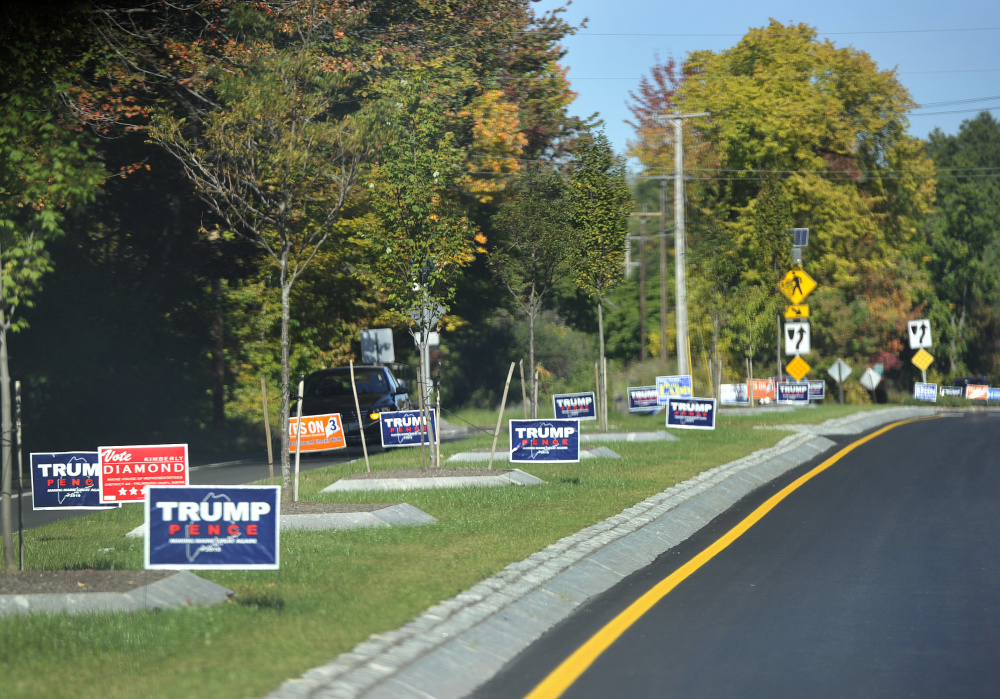Gov. Paul LePage said Friday that he is asking the Maine Department of Transportation to increase enforcement and removal of political signs along state highways that may be in violation of a new law.
A statement issued by LePage’s office said that “many constituents” have complained over the last few weeks that campaigns are not following a new law that allows signs to be placed in the public right-of-way but requires that signs with the same message be at least 30 feet apart. The new law allows signs to be in place for as long as six weeks each year and it limits a sign’s size to 4 feet-by-8 feet.
“Our administration has and will continue to enforce this law fairly for all political campaigns,” LePage said in a prepared statement.
Peter Steele, LePage’s communications director, said LePage has heard the complaints in person while traveling the state for official events and speaking engagements.
“The governor has heard personally from many Mainers concerned about signs promoting politicians and ballot questions, and DOT has been fielding a lot of these complaints,” Steele wrote in an email to the Press Herald.
The recent state law change was made to conform with a U.S. Supreme Court ruling and to mitigate public concerns about the overall density of signs along the road, the release said. The law does not apply to political signs that are installed on private property. The new law also limits the size of signs that are installed outside of the public right-of-way to 50 square feet.
The bill creating the new law, as it was originally proposed, would have required signs to be placed at least 200 feet apart.
According to the release, MDOT will notify a campaign if a sign does not follow the law, giving the campaign responsible for the sign a short time to comply.
“If the campaign does not follow this directive, the department will remove the sign and notify the campaign that it has been removed and is available for pickup at a department facility,” the release said.
The new law created a civil violation and up to a $250 fine for the illegal removal of signs in a public right-of-way.
Ted Talbot, a spokesman for MDOT, said the department receives complaints on a regular basis each election season but said the new law change was prompting an increase in the number of complaints.
He said ballot Question 3, on background checks for private gun sales, seems to be generating more complaints than the other campaigns, and signs in support of the ballot question appeared to be generating the bulk of the complaints.
But David Farmer, spokesman for Mainers for Responsible Gun Ownership, which is pushing the background checks initiative, said his campaign has talked with MDOT to make sure its signs comply, and that complaints about the group’s signs are a campaign tactic by opponents of Question 3.
“We will see if the Department of Transportation enforces this consistently with all the campaigns or only those campaigns with which the governor has a disagreement,” Farmer said Friday night in an email.
Talbot said MDOT right-of-way engineers are assigned the task of political sign enforcement or removal.
Talbot said campaigns and candidates, for the most part, are responsive and correct signs that are not in compliance with the law but said the Yes on 3 campaign had not been responsive to MDOT notifications, so signs in violation were being removed.
“There have been numerous, multiple contacts to campaigns and/or candidates and after those numerous contacts they still haven’t complied,” Talbot said. “So after multiple notifications we will get those signs.”
He said if the signs in question are not creating a safety hazard for motorists, campaigns and candidates are given a reasonable amount of time to correct a problem, usually at least a week, before MDOT removes the signs. Signs creating hazards for motorists or located in places clearly prohibited by law such as in so-called “control of access areas” roads leading to an on- or off-ramp are removed immediately when discovered, Talbot said.
Send questions/comments to the editors.



